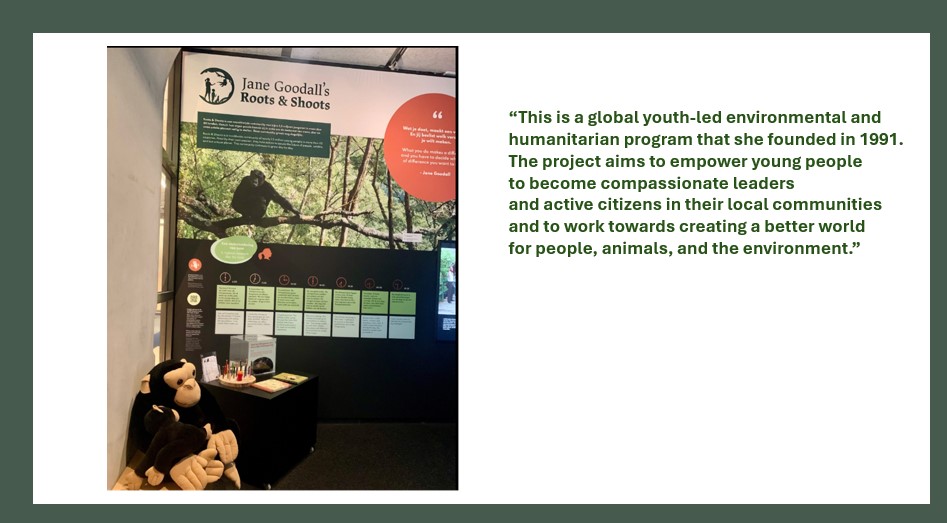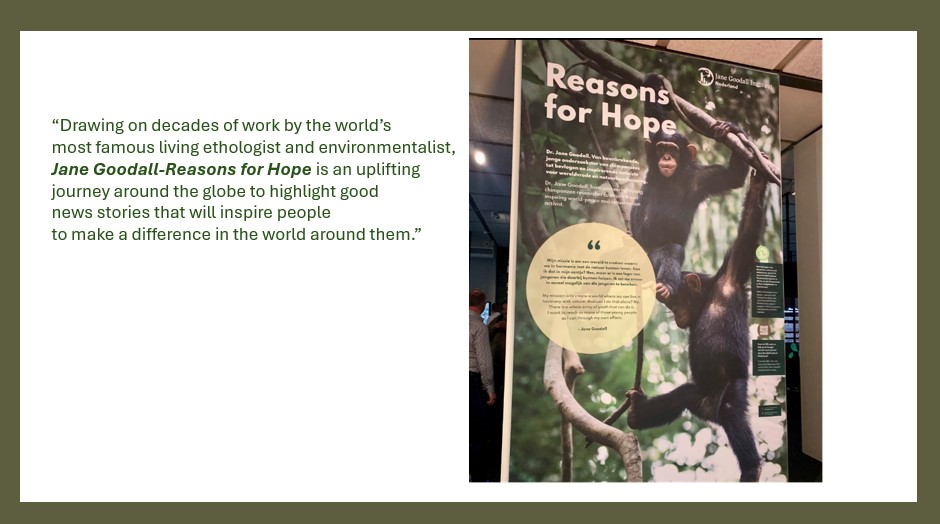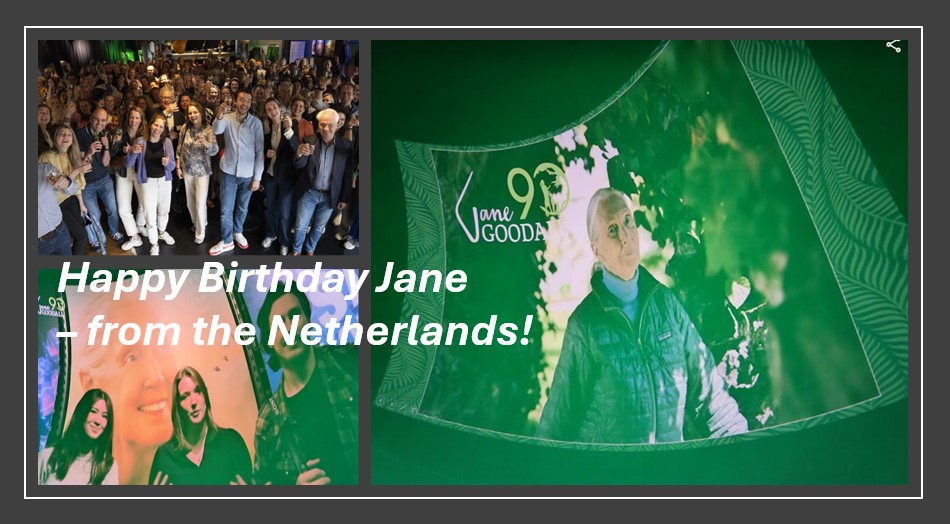Jane Goodall is a renowned primatologist, ethologist, and anthropologist, best known for her groundbreaking work with chimpanzees in Tanzania. Born on April 3, 1934, in London, England, Jane’s work has had a significant impact on our understanding of primate behaviour, conservation, and the relationship between humans and animals.
Her journey began in the 1960s when she travelled to Tanzania to study chimpanzees in their natural habitat at Gombe Stream National Park. Her approach of closely observing chimpanzees without intervening or imposing her presence too much revolutionized the field of primatology. Through her observations, Goodall discovered that chimpanzees use tools, a behaviour previously thought to be unique to humans, and she observed complex social behaviours within chimpanzee communities.
In addition to her scientific contributions, Jane is a passionate advocate for wildlife conservation and environmentalism. She founded the Jane Goodall Institute in 1977, which works to protect chimpanzees and their habitats, promote environmental education, and empower local communities to take action for conservation.
Throughout her life, she has received numerous awards and honours for her work, including being named a United Nations Messenger of Peace and being appointed Dame Commander of the Order of the British Empire (DBE). Her work continues to inspire people around the world to care for the natural world and work towards a more sustainable future.
On Saturday, April 6th I was a guest at her 90th birthday celebration at Museon/ Omniversum in the Hague. It was organised by the Jane Goodall Institute Netherlands which also promotes the youth program: ‘Roots & Shoots’.
This is a global youth-led environmental and humanitarian program that she founded in 1991. The project aims to empower young people to become compassionate leaders and active citizens in their local communities and to work towards creating a better world for people, animals, and the environment.
The “Roots” represent the ideas and values that support the project, such as respect for all living things, diversity, and interconnectedness. The “Shoots” symbolize the actions taken by young people to make positive changes in their communities.
Roots & Shoots projects cover a wide range of issues, including wildlife conservation, habitat restoration, sustainable development, animal welfare, and social justice. Participants are encouraged to identify local environmental and social problems and develop their own projects to address them, using creativity, collaboration, and critical thinking skills.
The program operates in over 50 countries and involves thousands of young people from preschool to university age. It provides resources, support, and a network for youth to connect with like-minded peers and mentors, as well as opportunities for leadership development and advocacy.
Roots & Shoots embodies Jane Goodall’s belief in the power of young people to effect positive change in the world and serves as a platform for them to become engaged global citizens and stewards of the planet.
The afternoon started with a viewing of the photo exhibition with information about her work and the making of the short documentary called “Reasons for Hope”.
As part of the afternoon celebrations, the documentary was shown in the Omniversum Dome.
Here is the trailer:
“Drawing on decades of work by the world’s most famous living ethologist and environmentalist, Jane Goodall-Reasons for Hope, is an uplifting journey around the globe to highlight good news stories that will inspire people to make a difference in the world around them.
Featured stories such as the Northern Bald Ibis’ migration over the Alps, the re-introduction of the American Bison by the Blackfeet Nation, the worldwide recognized Sudbury Regreening Story and inspiring youth-led initiatives involved in Jane Goodall’s Roots & Shoots align with historic footage of Jane’s beginnings as a chimpanzee researcher.
Throughout, the film reinforces Jane’s four pillars of hope that signal tremendous hope for the future: the amazing human intellect, the resilience of nature, the power and dedication of young people, and the indomitable human spirit.
Jane Goodall revolutionized how we view the world around us. Join her on this adventure of inspiration and hope.”
The Northern Bald Ibis, also known as Geronticus eremita, is a critically endangered bird species that was once widespread across Europe, Northern Africa, and the Middle East. However, due to habitat loss, hunting, and other factors, its population has declined dramatically, and it is now considered one of the rarest birds in the world.
One notable aspect of the Northern Bald Ibis’s behaviour is its migration pattern. In recent years, efforts have been made to reintroduce this species to parts of its former range. One such reintroduction project involves a population of Northern Bald Ibises that have been trained to follow ultralight aircraft on their migration routes.
During their migration, which typically occurs in the autumn, these birds fly over the Alps, crossing from their breeding grounds in Central Europe to their wintering grounds in Italy or Northern Africa. Flying over the Alps is a challenging feat for these birds, as they must navigate through mountainous terrain and potentially adverse weather conditions.
The migration of the Northern Bald Ibis over the Alps has captured the attention of conservationists and bird enthusiasts alike, highlighting the importance of efforts to protect and conserve this critically endangered species. It also serves as a reminder of the incredible journeys that migratory birds undertake each year and the need to safeguard their habitats and migration routes.
The re-introduction of the American Bison by the Blackfeet Nation is a significant conservation effort aimed at restoring a culturally and ecologically important species to its native habitat. The American Bison, often referred to as buffalo, once roamed the Great Plains in vast numbers, playing a crucial role in the ecosystem and serving as a cornerstone of Indigenous cultures like that of the Blackfeet Nation.
Historically, bison populations declined precipitously due to overhunting, habitat loss, and other factors, nearly driving the species to extinction. In recent decades, various groups and organizations, including Indigenous tribes like the Blackfeet Nation, have been actively involved in efforts to restore bison populations and their natural habitat.
The Blackfeet Nation, located in Montana, has been at the forefront of bison restoration efforts. They have established bison herds on tribal lands, reintroducing the animals to areas where they once thrived. These efforts not only contribute to the conservation of the species but also serve to revitalize cultural traditions and strengthen tribal sovereignty.
By re-introducing bison to their ancestral lands, the Blackfeet Nation and other Indigenous groups are reclaiming stewardship over the land and promoting the ecological health of the Great Plains. Bison restoration projects also have broader implications for biodiversity, grassland conservation, and the preservation of Indigenous knowledge and values.
Overall, the re-introduction of the American Bison by the Blackfeet Nation represents a powerful intersection of conservation, cultural revitalization, and Indigenous sovereignty, demonstrating the importance of collaboration between Indigenous peoples, governments, and conservation organizations in restoring balance to ecosystems and honouring traditional ways of life.
The Sudbury Regreening Story is a remarkable tale of environmental transformation in Sudbury, Ontario, Canada. Sudbury was once known as one of the world’s most heavily polluted cities, largely due to extensive mining operations, particularly for nickel, which had devastated the local landscape and ecosystem.
Throughout much of the 20th century, Sudbury’s environment suffered from severe air and water pollution, deforestation, and soil degradation. The landscape was characterized by barren, rocky terrain, devoid of vegetation and wildlife, earning Sudbury the nickname “moonscape”.
However, in the latter half of the 20th century, concerted efforts were made to address the environmental degradation in Sudbury and restore the landscape to its former glory. The Sudbury Regreening Story is a testament to the power of community engagement, scientific innovation, and government intervention in environmental restoration.
One key aspect of the regreening efforts in Sudbury was the implementation of land reclamation and rehabilitation projects on former mining sites. These projects involved the planting of millions of trees and the use of innovative techniques, such as soil stabilization and re-vegetation, to restore damaged ecosystems.
Additionally, measures were taken to reduce air pollution from mining and smelting operations, including the implementation of stricter environmental regulations and the adoption of cleaner technologies.
Over the decades, these efforts have led to a remarkable transformation of Sudbury’s landscape. The once-barren terrain is now characterized by lush forests, vibrant wetlands, and diverse wildlife habitats. Sudbury has become a model for environmental restoration and sustainable development, demonstrating that even the most degraded landscapes can be revitalized with determination, collaboration, and innovation.
The Sudbury Regreening Story serves as an inspiring example of how communities can come together to address environmental challenges and create a more sustainable future for generations to come.
Impressions of the birthday party in the Hague, April 6, 2024
Let’s wish Jane a belated happy birthday!
When asked what she would like for her birthday Jane responded with this video:
References:
Jane’s 90th birthday: https://www.janegoodall.nl/janes-90-verjaardagsfeest/
The re-introduction of the American Bison by the Blackfeet Nation
Regreening Sudbury, Canada https://www.cbc.ca/news/canada/sudbury/regreening-sudbury-1.6057530
The Northern Bald Ibis: https://www.facebook.com/photo/?fbid=650511640520427&set=pb.100066847915025.-2207520000
Jane’s birthday wish, Chimp Eden.







